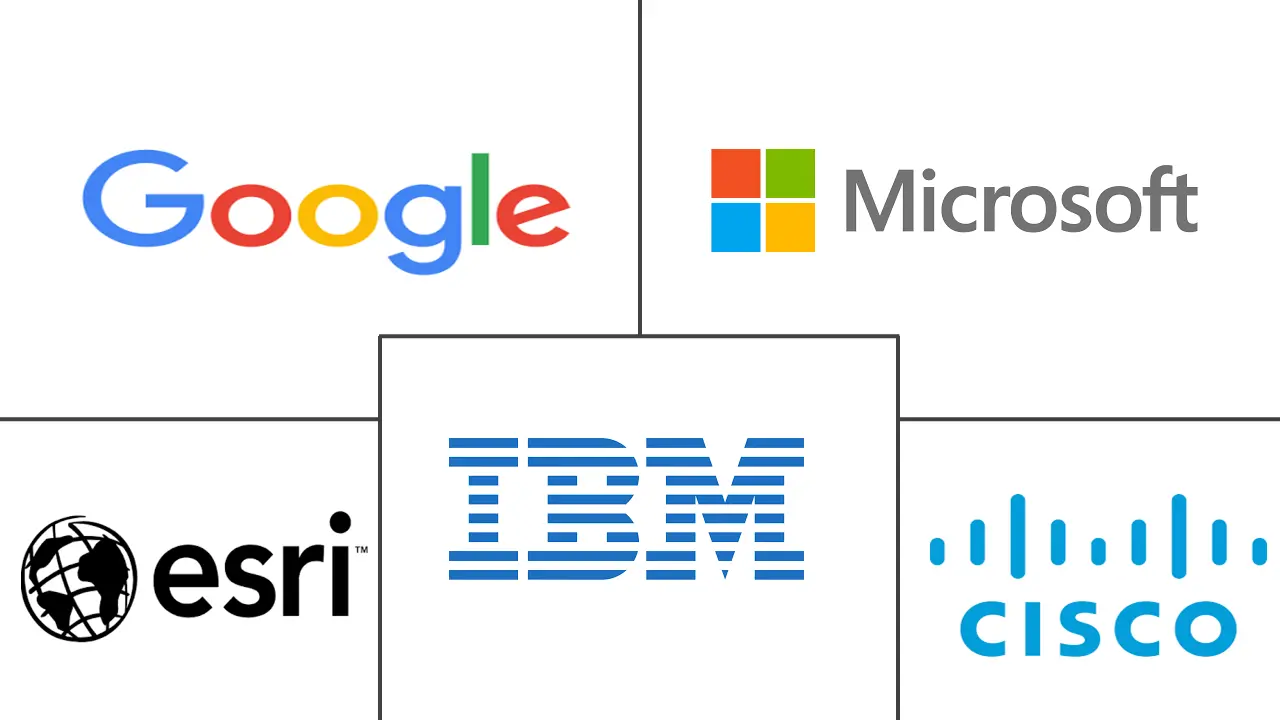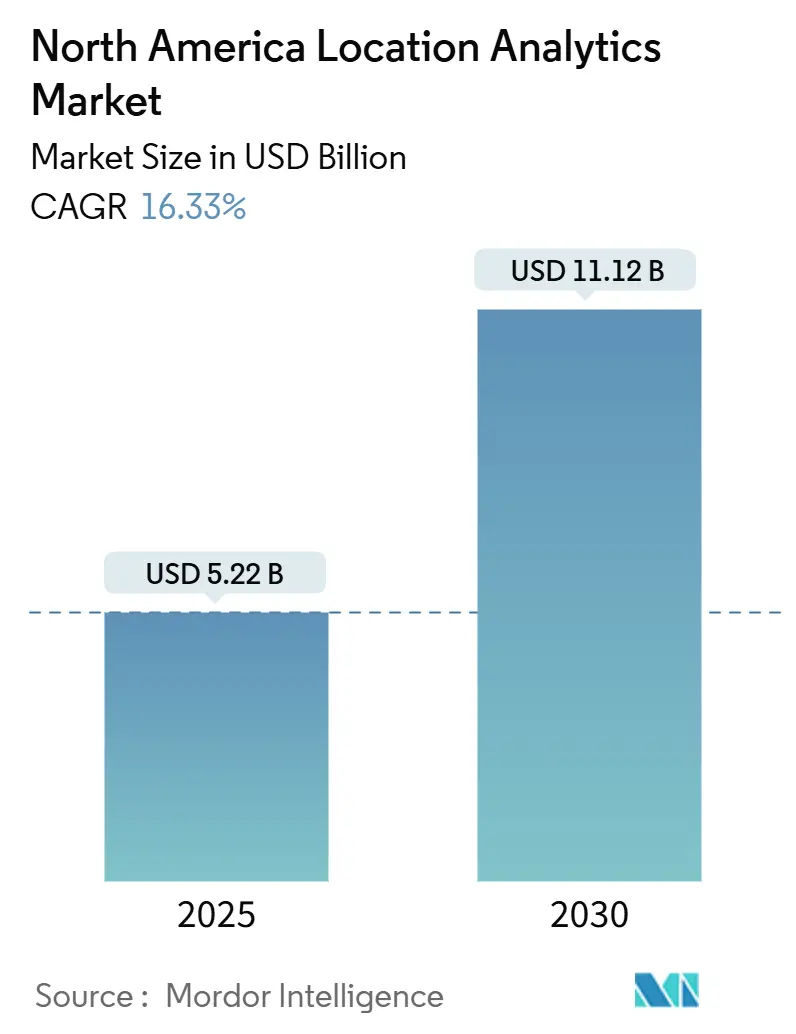
North America Location Analytics Market Analysis by Mordor Intelligence
The North America location analytics market size is valued at USD 5.22 billion in 2025 and is projected to advance to USD 11.12 billion by 2030, expanding at a 16.33% CAGR. Strong tailwinds come from omni-channel retail organizations demanding precise geo-marketing, the surge of IoT sensors streaming real-time spatial data, and widespread migration to cloud-native geospatial platforms that compress deployment cycles. Enterprises are moving beyond basic latitude-and-longitude tracking toward rich spatial analytics that optimize merchandising, routing, and facility throughput. Private-5G and CBRS networks shorten indoor accuracy gaps, while government investment in emergency-response geotechnology adds an institutional layer of demand. Rising privacy regulation represents the main tempering factor, yet compliant data-mining architectures are already emerging to keep momentum intact for the North America location analytics market.
Key Report Takeaways
- By location type, the outdoor segment led with 55% of North America location analytics market share in 2024, whereas indoor positioning is set to compound at 18.4% CAGR through 2030.
- By deployment model, on-premise retained 60% share of the North America location analytics market size in 2024; cloud deployment is forecast to accelerate at a 20.1% CAGR to 2030.
- By end-user vertical, retail and e-commerce commanded 37% share of the North America location analytics market size in 2024, while healthcare and life sciences is the fastest-expanding vertical at 16.4% CAGR.
- By geography, the United States controlled 86% of 2024 revenue; Canada is expected to post a 12.7% CAGR through 2030.
North America Location Analytics Market Trends and Insights
Drivers Impact Analysis
| Driver | (~) % Impact on CAGR Forecast | Geographic Relevance | Impact Timeline |
|---|---|---|---|
| Surge in omni-channel retail geo-marketing campaigns | +3.2% | US retail corridors | Medium term (2-4 years) |
| Proliferation of IoT sensors & connected devices | +4.1% | US manufacturing & Canadian smart-city pilots | Long term (≥ 4 years) |
| Accelerated adoption of cloud-native geospatial analytics platforms | +2.8% | North America enterprise segment | Short term (≤ 2 years) |
| Corporate demand for hybrid workplace occupancy intelligence | +2.3% | Major metropolitan areas | Medium term (2-4 years) |
| Availability of CBRS private-5G improving indoor accuracy | +1.9% | US industrial corridors | Long term (≥ 4 years) |
| Source: Mordor Intelligence | |||
Surge in Omni-Channel Retail Geo-Marketing Campaigns
Retailers pair geofencing tools with CRM suites to trigger real-time promotions, driving higher conversion at store level. Showroom optimization research indicates that strategic in-store product placement and geographic reach expansion lift sales and consumer confidence. As brick-and-click convergence deepens, differentiated location content becomes a loyalty lever that pure-play e-commerce cannot replicate.
Proliferation of IoT Sensors & Connected Devices
Industrial IoT deployments now deliver continuous location telemetry, enabling predictive maintenance and lean inventory cycles. Multi-modal sensor networks combined with machine learning yield positioning systems that self-calibrate, cutting infrastructure spend over time.. The data deluge fuels edge-analytic demand, as manufacturers prefer local processing for latency-sensitive safety workflows.
Accelerated Adoption of Cloud-Native Geospatial Analytics Platforms
Enterprises are abandoning legacy GIS estates for cloud environments that support direct access to cloud-optimized GeoTIFF. The shift democratizes spatial insight across non-specialists who can visualize layers in browser workspaces while DevOps teams automate pipelines. Vendor ecosystems now bundle API-first geospatial services, trimming the total cost of ownership previously tied to on-premise stacks.
Corporate Demand for Hybrid Workplace Occupancy Intelligence
Permanent flexible-work policies push facility leaders to install indoor positioning to monitor desk utilization, ventilation needs, and traffic patterns. Results from healthcare trials underscore how real-time location systems enhance worker productivity and asset stewardship. Facilities teams now blend occupancy analytics with building-management controls to automate energy usage around live capacity metrics rather than static timetables.
Restraints Impact Analysis
| Restraint | (~) % Impact on CAGR Forecast | Geographic Relevance | Impact Timeline |
|---|---|---|---|
| Heightened privacy and consumer opt-out regulations | –2.7% | California, expanding across North America | Short term (≤ 2 years) |
| High total cost of ownership for real-time indoor systems | –1.8% | Manufacturing & healthcare campuses | Medium term (2-4 years) |
| Source: Mordor Intelligence | |||
Heightened Privacy and Consumer Opt-Out Regulations
California’s CCPA enforcement sweep spotlights the personal nature of geolocation data, requiring explicit opt-outs and stronger consent flows.[1]California, Consumer Privacy Act Regulations, California Privacy Protection Agency cppa.ca.gov cppa.ca.gov Enterprises must now embed privacy engineering into every analytics stack, sometimes trimming data granularity to stay compliant.
High Total Cost of Ownership for Real-Time Indoor Systems
Ultra-wideband, BLE beacons, and Wi-Fi fingerprinting must be fine-tuned per floor plan, creating testing cycles that inflate roll-out budgets. Integration gaps between sensor layers and business applications lengthen payback periods, especially for mid-market adopters who lack in-house geospatial talent
Segment Analysis
By Location Type: Indoor Positioning Drives Innovation
Outdoor services retained 55% North America location analytics market share in 2024 as GPS/GNSS underpins transportation and logistics. Indoor positioning, however, compounds at 18.4% CAGR, powered by sub-meter accuracy from CBRS-enabled private 5G and ultra-wideband deployments.[2]5G Indoor Advance Positioning is a game changer Ericsson Blog, Ericsson, ericsson.com Manufacturers embed the technology for asset-level visibility, while hospitals apply it to track high-value equipment.
Growing hybrid demand obliges vendors to fuse indoor and outdoor layers into single source-of-truth dashboards. Industry 4.0 blueprints call for worker safety geozones and automated guided vehicles requiring continuous coordinate streams. The North America location analytics market therefore pivots to multi-modal engines that reconcile GPS drift outdoors with multipath corrections indoors.
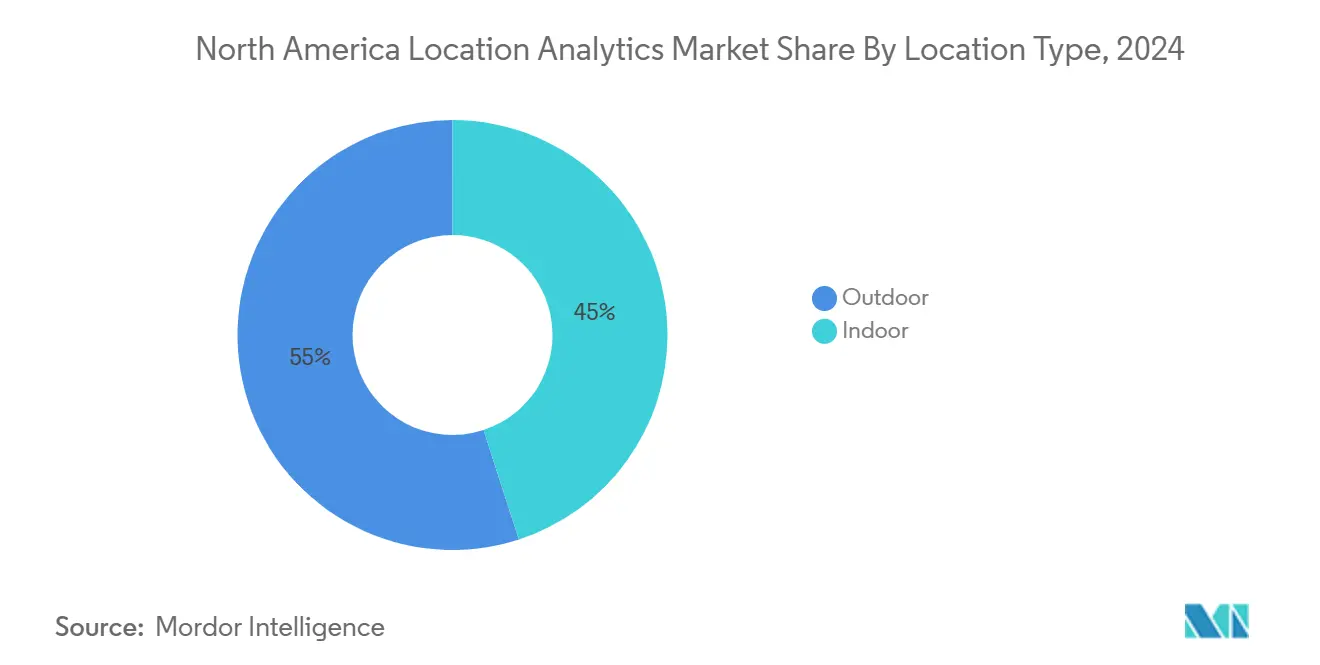
By Deployment Model: Cloud Acceleration Reshapes Infrastructure
On-premise systems still accounted for 60% of the North America location analytics market size in 2024, reflecting data-sovereignty priorities among heavily regulated sectors. Cloud options are scaling at a 20.1% CAGR as pay-as-you-go processing and native collaboration entice enterprises with limited capex. Hybrid architectures are also rising, combining edge inference with cloud modeling for low-latency use cases.
Private CBRS networks offer an on-site alternative that marries cloud orchestration with sovereign data paths, giving factories a route around public-cloud lock-in. Format innovations such as GeoParquet minimize ETL overhead, unlocking agile workflows that previously demanded specialist GIS scripting.
By Component: Solutions Drive Market Value
Integrated software suites dominate buying centers because they unify ingestion, processing, visualization, and alerting under one SLA. Services revenues expand as enterprises require system integration, model tuning, and managed-analytics oversight to maintain mapping fidelity. Field calibration, beacon lifecycle management, and compliance documentation fuel professional-services pipelines well after initial deployment.
Managed services add predictable opex, allowing business teams to focus on customer KPIs rather than sensor uptime. Vendors respond by offering tiered NOC support, proactive firmware pushes, and SLA-bound accuracy audits that align with uptime expectations in logistics and healthcare.
By Technology: Multi-Modal Approaches Enhance Accuracy
GPS/GNSS remains universal for long-range tracking, yet Bluetooth Low Energy blends minimal power draw with smartphone ubiquity for in-store navigation. Ultra-wideband earns traction for sub-meter precision on high-value assets where every centimetre matters. CBRS and 5G add deterministic timing data that lifts indoor fidelity without extra hardware overlay.
Hybrid engines stitch multiple signals to cover blind spots, ensuring resilience if one modality drops. Such redundancy is becoming baseline in safety-critical verticals, particularly chemical manufacturing and emergency response command centers.
By End-User Vertical: Healthcare Accelerates Adoption
Retail and e-commerce maintained 37% share of the North America location analytics market size in 2024, but healthcare and life sciences now grows fastest at 16.4% CAGR. Clinics deploy location analytics to shorten equipment retrieval times and map patient flow, cutting overcrowding risks. Manufacturers layer spatial data into MES dashboards for OEE improvements, while BFSI leverages geofencing for fraud checks.
Government and defense agencies invest in next-generation situational-awareness platforms that ingest geospatial feeds to speed decision loops.[3]Preparedness through Innovation, U.S. Department of Homeland Security dhs.gov, dhs.gov Logistics providers overlay fleet telematics with traffic and weather, refining ETAs and SLA compliance in last-mile delivery.
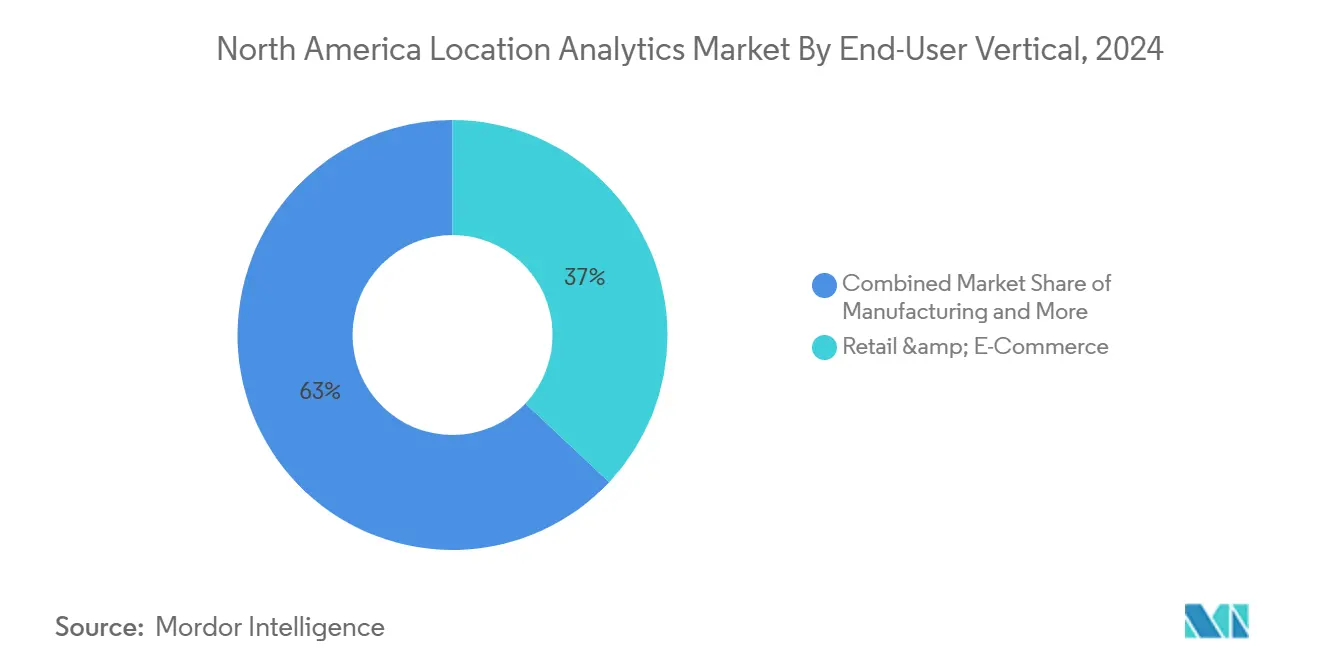
Note: Segment shares of all individual segments available upon report purchase
By Application: Emergency Response Gains Strategic Priority
Sales and marketing held 29% of 2024 revenue, yet emergency-response software shows an 18.7% CAGR as agencies digitize command workflows. The Department of Homeland Security’s POINTER navigation trials illustrate the pivot to responder-centred mapping that penetrates GPS-denied buildings. Supply-chain optimization stacks sit close behind, pairing RFID, BLE, and analytics to shrink stock-outs and working capital.
Risk-management teams overlay catastrophe models with live hazard feeds, improving capital allocation for insurers. Field-service managers now dispatch crews using AI-routed schedules that factor traffic, weather, and technician skill matrices to minimise downtime.
Geography Analysis
The United States commanded 86% of the North America location analytics market in 2024, underpinned by CBRS deployment density and 5G roll-outs that expand indoor coverage. Federal contracts from the National Geospatial-Intelligence Agency and the Department of Homeland Security keep R&D funnels active, spinning cutting-edge prototypes into commercial spin-offs. California’s privacy regime is tightening data-monetization paths in consumer segments, but enterprise B2B flows continue largely unhindered.
Canada is pacing a 12.7% CAGR to 2030 as Ottawa’s connectivity stimulus underwrites 5G and fiber builds in secondary cities. Resource industries leverage autonomous haul-trucks in Alberta oil sands and remote pumping stations in Saskatchewan, each dependent on resilient location networks. Cross-border enterprises enjoy harmonized data standards, enabling joint dashboards that span logistics corridors between Toronto and Chicago.
Regional government programs such as Montréal’s smart-city accelerator and Vancouver’s digital twin of municipal infrastructure foster pilot zones where vendors can co-create novel use cases. Canada’s privacy code aligns closely with European GDPR, giving multinationals a template to scale compliant solutions across trans-Atlantic operations.
Competitive Landscape
The competitive field is moderately concentrated. Traditional GIS giants such as Esri, HERE, and TomTom fortify portfolios with AI-powered predictive layers, while telecom vendors Ericsson and Nokia monetize 5G infrastructure by bundling centimeter-grade positioning. Cloud hyperscalers integrate managed geospatial APIs into broader analytics suites, lowering adoption barriers for mid-sized firms.
Differentiation is shifting from core mapping to orchestration of multi-modal inputs—BLE, UWB, private LTE, and satellite imagery—within a unified schema. Vendors able to abstract this complexity win wallet share as customers seek single-pane dashboards. Healthcare and heavy-industry specialists carve niches by wrapping compliance templates and pre-configured analytics tuned to regulatory workflows.
Start-ups exploit edge processing and federated-learning designs that keep sensitive coordinates on-premise, solving data-sovereignty pain points. M&A appetite is robust as incumbents acquire sensor specialists and indoor-mapping start-ups to fill platform gaps. Expect continued consolidation as hardware commoditizes and analytical value migrates to software-defined location engines.
North America Location Analytics Industry Leaders
Esri Inc.
IBM Corporation
Microsoft Corporation
Cisco Systems Inc.
Google LLC
- *Disclaimer: Major Players sorted in no particular order
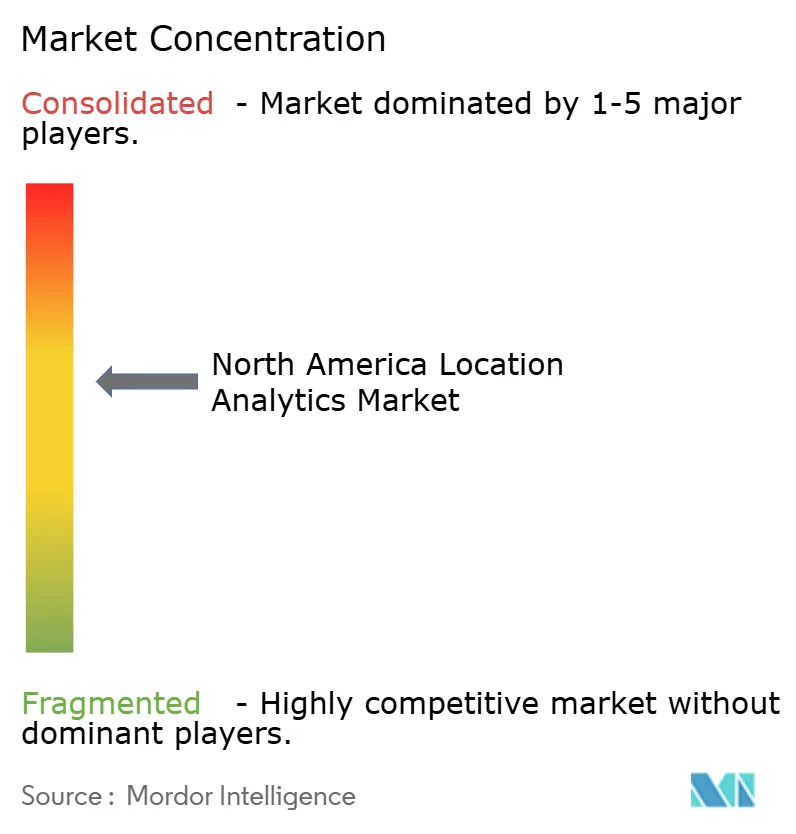


Recent Industry Developments
- April 2025: Department of Homeland Security expanded its first-responder tech suite with indoor navigation and physiological monitoring tied to location feeds
- March 2025: California Privacy Protection Agency began an enforcement sweep on geolocation practices, reinforcing opt-out obligations for data brokers
- March 2025: OnGo Alliance issued deployment guidelines that simplify enterprise CBRS roll-outs for location analytics
- January 2025: Pacific Northwest National Laboratory upgraded RADR to merge AI damage assessment with high-resolution geospatial imagery for disaster management
Research Methodology Framework and Report Scope
Market Definitions and Key Coverage
According to Mordor Intelligence, we define the North America location analytics market as all revenue earned from software and related services that append geographic coordinates to enterprise or public data to surface spatial patterns across fixed and mobile assets. The valuation covers indoor and outdoor positioning solutions deployed on-premise, cloud, or edge and applied in functions ranging from retail footfall optimization to emergency response routing.
Scope exclusion: We exclude GPS chipset hardware, raw satellite imagery sales, and generic business intelligence tools lacking spatial capability.
Segmentation Overview
- By Location Type
- Indoor
- Outdoor
- By Deployment Model
- On-premise
- Cloud
- Hybrid
- Edge (on-device)
- By Component
- Solutions
- Services
- By Technology
- GPS / GNSS
- Wi-Fi
- Bluetooth Low-Energy (BLE)
- Ultra-Wideband (UWB)
- Cellular (4G/5G incl. CBRS)
- RFID & NFC
- Magnetic & Other
- By End-User Vertical
- Retail & E-Commerce
- Banking, Financial Services & Insurance (BFSI)
- Manufacturing
- Healthcare & Life Sciences
- Government & Defense
- Energy & Utilities
- Transportation & Logistics
- Telecom & IT
- Real Estate & Smart Buildings
- Other Verticals
- By Application
- Risk Management
- Supply Chain & Inventory Optimization
- Sales & Marketing Optimization
- Facility & Asset Management
- Workforce & Field-Force Management
- Remote Monitoring & Predictive Maintenance
- Emergency & Disaster Response Management
- Customer Experience & Engagement
- Fraud & Compliance Analytics
- Others
- By Country
- United States
- Canada
- Mexico
Detailed Research Methodology and Data Validation
Primary Research
Our team interviewed mapping technologists, omni-channel retail marketers, and municipal emergency planners across the United States and Canada. These talks clarified price dispersion, deployment hurdles, and the emerging swing toward edge-processed analytics.
Desk Research
We began with US Census TIGER/Line layers, FCC spectrum logs, Statistics Canada digital economy tables, and IEEE papers on indoor accuracy. Trade bodies like the Location Based Marketing Association and National Retail Federation offered adoption ratios, while SEC 10-Ks and investor slides outlined pricing arcs. Paid sources such as D&B Hoovers for company splits and Factiva for deal flow completed desk evidence. This list is illustrative; many other references guided checks.
We linked smartphone shipments (CTIA), private 5G license counts, and cloud GIS workload benchmarks with patent tallies from Questel and shipment records via Volza to gauge beacon momentum.
Market-Sizing & Forecasting
We applied a top-down construct that starts with regional IT analytics spend and overlays measured penetration rates for location-aware workloads. We then calibrate totals with sampled vendor roll-ups and channel checks. Key inputs include smartphone penetration, enterprise IoT endpoints, cloud GIS spend, indoor navigation square-foot coverage, and average subscription prices. Multivariate regression projects to 2030, and selective bottom-up cross-checks hold variance within five percent. Missing supplier disclosures are bridged with peer benchmarks tuned for workforce and product mix.
Data Validation & Update Cycle
Each model moves through anomaly scans, senior analyst reviews, and leadership sign-off. Before sign-off, we ensure results are current. Figures refresh annually, with interim updates when material events such as policy shifts or landmark acquisitions arise.
Why Mordor's North America Location Analytics Baseline Commands Reliability
Published values differ because providers fold in wider geospatial segments, bundle hardware, or stretch growth multipliers. We refresh our segmentation yearly to narrow such gaps.
We found key gap drivers include mixing geospatial analytics with imagery licensing, scaling from global shares without verifying North American cloud uptake, and freezing currency assumptions over long horizons.
Benchmark comparison
| Market Size | Anonymized source | Primary gap driver |
|---|---|---|
| USD 5.22 Bn (2025) | Mordor Intelligence | - |
| USD 8.67 Bn (2025) | Regional Consultancy A | Adds satellite imagery and broader geospatial tools |
| USD 7.75 Bn (2024) | Global Consultancy B | Uses wider "location intelligence" scope, historic ASPs |
| USD 6.43 Bn (2024) | Trade Journal C | Scales US data to region with fixed share |
Our comparison shows Mordor's stepwise variable selection and dual validation give decision-makers a balanced, transparent baseline they can confidently adapt.


Key Questions Answered in the Report
What is the current size of the North America location analytics market?
The market is valued at USD 5.22 billion in 2025.
How fast is the North America location analytics market expected to grow?
It is forecast to post a 16.33% CAGR, reaching USD 11.12 billion by 2030.
Which deployment model is gaining the most momentum?
Cloud deployment is rising at a 20.1% CAGR as enterprises seek scalability and lower infrastructure costs.
Why is healthcare the fastest-growing vertical?
Hospitals need real-time asset tracking and patient flow optimization, pushing healthcare to a 16.4% CAGR through 2030.
Page last updated on:
